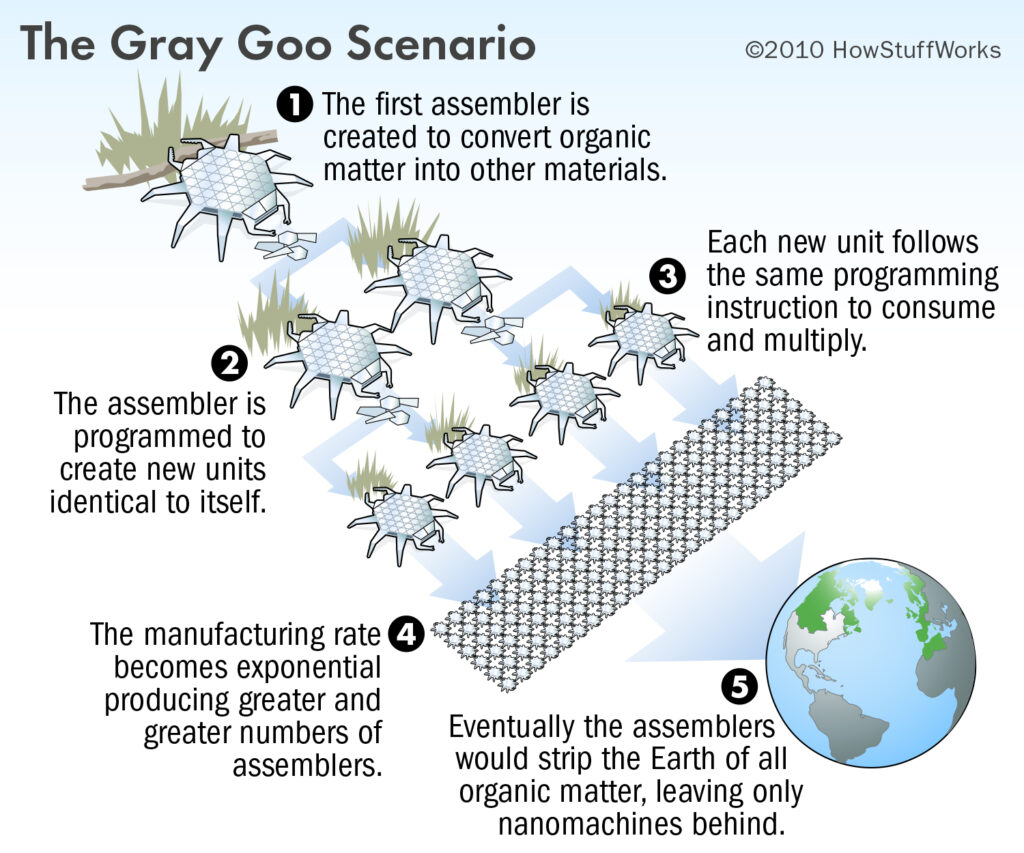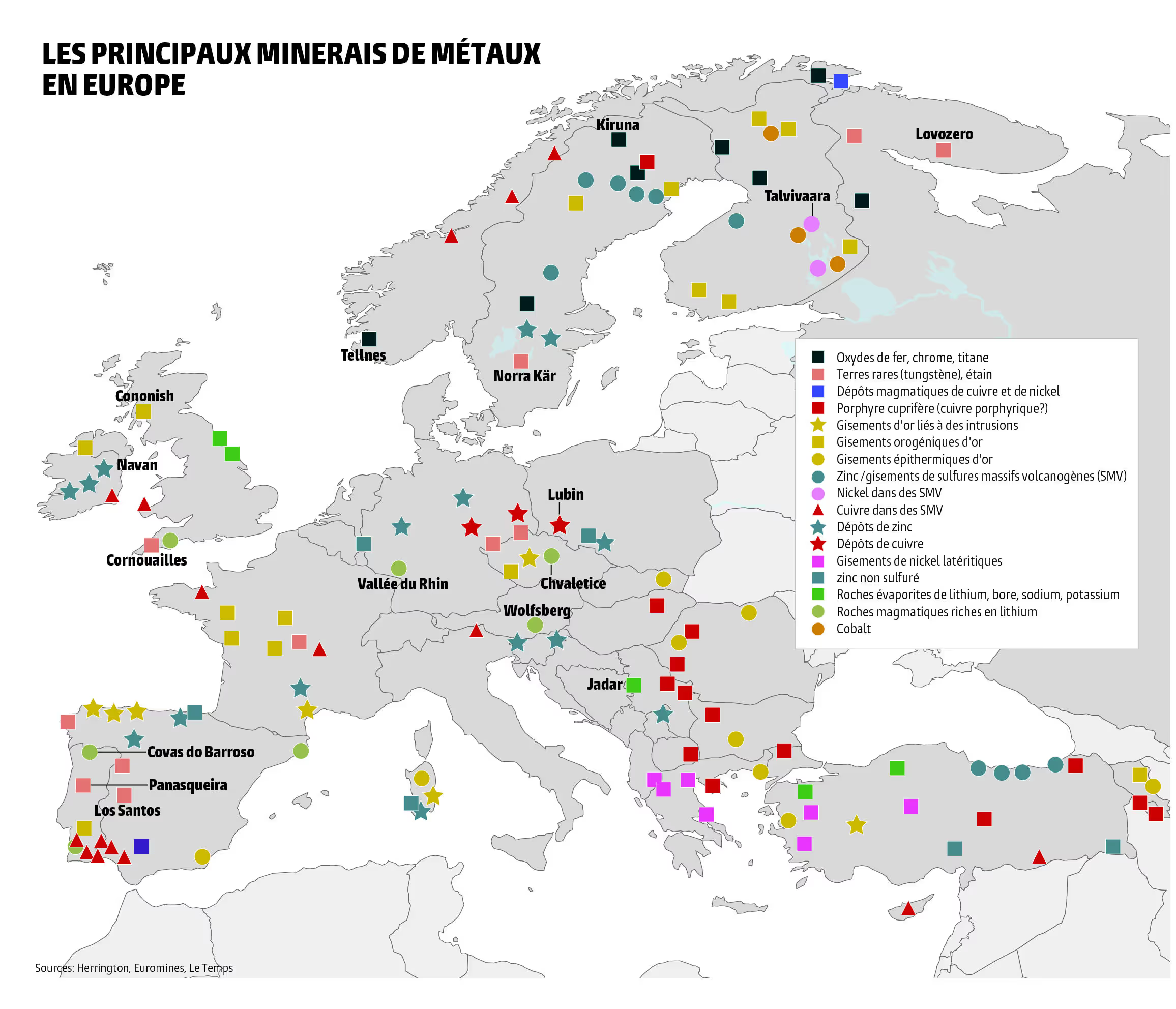“Several countries are developing nanoweapons. These could be used to launch attacks using miniature nuclear bombs and deadly insect robots.
Although they are still science fiction today, according to one expert, advances in nanotechnology in the years to come will make them a greater threat to humanity than conventional nuclear weapons. The United States, Russia, and China would invest billions of dollars in nanoweapon research. According to Louis Del Monte, physicist and prospectivist author of Nanoweapons: A Growing Threat To Humanity (“Nanoweapons: a growing threat to humanity”):
“Nanorobots are the main concern. They have the potential to become weapons of mass destruction and could lead to the annihilation of the human species.[1].””
— Jeff Daniels, article published on American economic media CNBC, 2017
We have reproduced several passages from the book Our last century? (2004) by the famous British astrophysicist Martin Rees. This is the second part of this selection, the first is to be consulted hither.
Image: In 2021, Chinese scientists succeeded, using 3D printers, in creating hydrogel structures in the shape of fish or crabs. The first is capable of swallowing molecules, the second of holding them in its tweezers in order to release them at the desired location. For the time being, these nanomachines are guided to their target using magnetic fields. As usual, technocracy is selling the thing to us as a major advance in medicine, because this innovation would make it possible to precisely target tumors. Obviously, this medical innovation, like all the others before them, will never eradicate cancer and will serve above all to fatten the scientific entrepreneurs who develop them. It is just as obvious that the military applications of micro-robots are numerous.
Artificial viruses?
All epidemics prior to the year 2000 (except, perhaps, that of anthrax that occurred in Russia in 1979) were caused by natural pathogens. Today, advances in biotechnology raise other concerns. According to a study conducted in June 2002 by the American Academy of Sciences, “a few specialists with access to a laboratory could cheaply manufacture a variety of lethal biological weapons that could seriously threaten the American population. These individuals could also create these biological agents using commercially available equipment, i.e. equipment that is used to manufacture chemical, pharmaceutical, food or beer products, and which would therefore be completely harmless. The deciphering of the human genome sequence and the complete elucidation of numerous pathogenic genomes... mean that science can be used to create new agents of mass destruction.”
While this report highlights the “bright side” of new technologies — they make it possible to identify the appearance of a pathogen and to react to it more quickly — it is no less worrying. Because he admits, even if terrorist groups are currently more suspected, that an “isolated” individual such as exists everywhere, knowing how to carry out genetic manipulations and cultivate microorganisms, could by itself trigger an epidemic with catastrophic consequences. In 2002, the American authorities approved a considerable increase in the budget for the defence against biological attacks; the unfortunate consequence of this measure is that know-how in this field will become accessible to the greatest number of people. According to George Poste, a British biologist and official advisor now working in the United States, “the 'Biotechnology 101' program is increasingly part of the university curriculum around the world; assuming that [Unabomber] was a student in the 1990s, it would be interesting to ask whether, instead of using bombs, he would not have chosen to carelessly drop such an object into a hamburger factory.”
In June 2002, Eckard Wimmer and his colleagues at New York University announced that they had developed a polio virus using DNA and a genetic program obtained on the Internet. This artificial virus poses few risks in that almost all of us are vaccinated against polio, but it would not be very complicated to manufacture infectious or even fatal variants of it. Experts had long known that this synthesis was plausible, and some blamed Wimmer for doing a useless experiment to get attention. But for this researcher, the discovery that viruses can be made so easily “is chilling.” Viruses such as smallpox, whose genomes are more complex than that of polio, are technically more difficult to replicate; in addition, one could only recreate that of smallpox by adding the reproductive enzymes from other polio viruses. Simpler viruses that are also deadly — such as HIV and Ebola, for example — could nevertheless be created today by combining individual gene chromosomes, as Wimmer did.
In a few years, the genetic projects of a large number of viruses, including those of animals or plants, will be archived in laboratory databases and researchers will be able to obtain them on the Internet. The Ebola genetic project, for example, is already available, and thousands of people are in a position to manufacture it using commercially available DNA fibers. In the 1990s, followers of the Aum Shinrikyo sect tried to find the Ebola virus in its natural state in Africa — unsuccessfully, as it is thankfully rare, but they would be more easily able to do so today in a personal laboratory. Personal computers and the Internet have indeed opened up enormous opportunities for apprentice scientists. This is a welcome development in a field such as astronomy, but reasons for concern remain, given the resources currently available to a well-informed community of amateur biologists.
The creation of synthetic viruses is a flourishing technology, which allows medicine to better understand the human immune system, but it also makes things easier for those whose aim is to suppress this immunity. A series of synthetic viruses that lack an antidote and against which one could not be immune could have even more devastating global consequences than those of AIDS currently in Africa, where it is rolling back decades of economic progress — an equivalent of smallpox without a vaccine, for example, or a virus that spreads faster than smallpox, or a variant of AIDS that can be transmitted like the flu, or a version of the Ebola virus, for example, or a version of the Ebola virus, which would have a longer incubation period. (The consequences of this horrible contagious disease are generally limited because it acts very quickly, its victims succumbing to the gnawing of flesh without having time to infect those around them, unlike AIDS, whose slow incubation facilitates transmission.)
If the new viruses created are not accompanied by the corresponding vaccines, we could become as vulnerable as American Indians decimated by diseases imported by European pioneers against which they were not immune.
It is also possible that artificial viruses “shake up the order of things” and cause changes that are more radical than those of natural mutation. Because of this, there are already bacteria that are not receptive to antibiotics — some hospital departments are infested with “microbes” that are even resistant to the last resort antibiotic Vancomycin — but other strains of this type can be cultivated. Just as we could invent new organisms whose role would be to attack plants and even inorganic substances.
And perhaps we will soon see the emergence of new types of synthetic microbes that are genetically engineered. Craig Venter, former CEO of Celera, a company that sequenced the human genome, has already announced that he intends to create new microbes that could respond to our energy and global warming problems: some would fragment water into oxygen and hydrogen (for the “hydrogen economy”), others would feed on carbon dioxide in the atmosphere (and in so doing, fight the greenhouse effect) and would convert it into organic chemicals such as those based on oil and gas that currently exist. The Venter technique consists, among other things, in making an artificial chromosome from about five hundred genes and in inserting it into an existing microbe whose genome has been destroyed by radiation. If this technique were successful, it would make it possible to consider the creation of new forms of life that feed on other materials present in the environment. For example, fungi could be created that would ingest polyurethane plastic and destroy it. The machines themselves would not be immune: bacteria specially designed to transform oil into crystalline material could thus cause breakdowns.
Experimental errors
A recent event in Australia illustrates worryingly the increase in risks associated with laboratory experiments, more due to errors and hazards than to malice.[2]. Ron Jackson worked at the Animal Control Cooperative Research Center in Canberra, a state laboratory whose main mission is to improve pest control techniques. With his colleague Lan Ramshaw, he was looking for new ways to reduce mouse populations, their idea being to modify the mouse pox virus to make it an infectious contraceptive and sterilize these rodents. During their experiments in early 2001, they inadvertently created a new, highly virulent strain of smallpox and all the mice in the laboratory perished: the researchers added a gene to the interleukin-4 protein that increased antibody production and suppressed the animals' immune systems; therefore, even those who had been vaccinated against smallpox were also dead. Assuming that the two men had worked on the human pox virus, could they have modified it too and made it even more virulent, thus making the vaccine ineffective? As Richard Preston says, “only a sense of responsibility between biologists prevents humans from creating a supervirus.”
These laboratory experiments, which may unintentionally create pathogens that are more dangerous than expected and perhaps more virulent than any that ever existed in their natural state, are the types of dangers that scientists will face — and that they should try to minimize — in other areas of research, including nanotechnology (and even fundamental physics). Nanotechnology promises a lot in the long term, but its drawbacks could prove to be more unfortunate than any biological error. We can imagine a scenario that is still improbable — that it would be possible to manufacture nanomachines capable, if left to their own devices, of reproducing exponentially until they “starve”. If their consumption were very selective, these machines would usefully replace chemical factories, as perhaps “synthetic viruses” would. But things would get worse if these machines were designed to be more omnivores than bacteria and even capable of swallowing organic materials. Thanks to efficient metabolism and solar energy, they would proliferate without control and would not reach the Malthusian limit until they had ingested all forms of life.
Eric Drexler called this cascade of events “the grey goo scenario.”
““Plants” with “leaves” that are not much more effective than our current solar collectors could defeat real plants and invade the biosphere with inedible foliage. Resistant omnivorous “bacteria” could defeat real bacteria and spread through the air like pollen, reproduce rapidly and, in the space of a few days, destroy the biosphere to nothing. Dangerous “replicators” could easily turn out to be too small and too tough and reproduce too quickly to be stopped — at least if we don't take the lead. We are already having a hard time controlling viruses and fruit flies.”

The sudden population of these “biovoracous replicators” could then devastate a continent in a few days. This worst-case scenario is entirely theoretical, but it suggests that the technological development of self-reproducing machines could eventually lead to a rapidly spreading disaster. Should we take the danger of the “grey goo scenario” seriously, even if we extend our forecasts over a century? A rapid spread of these replicators would not be scientifically impossible but this does not make them a serious risk. Another futuristic technology — a space rocket whose fuel would be anti-matter, and whose speed would be 90% that of light — is also scientifically possible, but we are far from having the technical resources, and we know it. Perhaps these hyper-efficient breeding animals that feed on the biosphere are as unrealistic as a “starship”, another example that complies with scientific laws and is therefore theoretically possible but far from probable? So should we only see the ideas of Drexler and others as science fiction intended to be scary? Viruses and bacteria are themselves superbly designed nanomachines, and an omnivorous eater capable of growing anywhere would win the race for natural selection. So Drexler's critics might be surprised that this disaster of destructive organisms did not arise through natural selection long ago. Why would the biosphere only be threatened by creatures born of a misguided human intelligence instead of having self-destroyed “naturally”? One of the answers to this argument is that humans can engineer mutations of which nature is incapable: geneticists can make monkeys or wheat fluorescent by transferring a jellyfish gene, while natural selection cannot thus bypass species barriers. Likewise, nanotechnology achieves, in the space of a few decades, what nature never achieves.
After 2020, advanced manipulations of viruses and cells will become commonplace and integrated computer networks will have taken control of many aspects of our lives. All forecasts for the middle of the century fall within the domain of conjectures and “scenarios.” By then, nanorobots may have become a reality; in fact, there may be so many of us trying to make nanoreplicators that a single attempt could trigger a disaster. It's easier to imagine extreme threats than effective antidotes.
These concerns about a seemingly distant future should not make us forget the various hazards discussed in this chapter, as they are already present and expanding. They should inspire us at least as much “pessimism” as that of the first atomic scientists a century ago in the face of the nuclear threat. The severity of a threat depends on its magnitude, multiplied by its probabilities: this is how we assess our concerns about hurricanes, asteroid impacts, and epidemics. If we apply this process to all future risks associated with human activities, we can expect the hands of the end-time clock to get even closer to midnight.
Martin Rees







